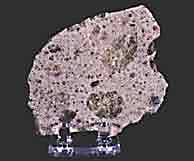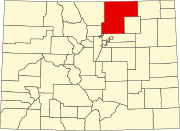Johnstown, Colorado | |
|---|---|
 Town Hall | |
| Motto: Community that Cares | |
 Location of Johnstown in Larimer County and Weld County, Colorado. | |
| Coordinates: 40°20′13″N 104°54′44″W / 40.33694°N 104.91222°W[2] | |
| Country | |
| State | |
| Counties[1] | Larimer, Weld |
| Platted | 1902 |
| Incorporated (town) | May 13, 1907[3] |
| Government | |
| • Type | Home Rule Municipality[1] |
| • Mayor | Michael Duncan |
| Area | |
| • Total | 13.84 sq mi (35.84 km2) |
| • Land | 13.75 sq mi (35.62 km2) |
| • Water | 0.09 sq mi (0.22 km2) |
| Elevation | 4,852 ft (1,479 m) |
| Population | |
| • Total | 17,303 |
| • Density | 1,300/sq mi (480/km2) |
| Time zone | UTC-7 (Mountain (MST)) |
| • Summer (DST) | UTC-6 (MDT) |
| ZIP code[6] | 80534 |
| Area code | 970 |
| FIPS code | 08-39855 |
| GNIS feature ID | 180701[2] |
| Website | Town of Johnstown |
Johnstown is a home rule municipality in Weld and Larimer counties in the U.S. state of Colorado. The population was 17,303 at the 2020 United States Census.[5]
History
[edit]The Town of Johnstown began with the vision of Harvey J. Parish before its platting in 1902. When Parish realized that the Great Western Railway was building close to his homestead, he purchased land for $11/acre and platted the land that would later be known as Johnstown. The original plat of Johnstown contained no more than 10 acres. Lots were 25'x140' with 20' alleys. Johnstown's main street, now known as Parish Avenue, was originally named Greeley Avenue Public Road.[7] Incorporated in 1907, Johnstown was named for Parish's son, John. When asked what he would call his new Town, he replied, "It will be my son's town. Let's call it John's Town."[7] John Parish would later serve as Mayor from 1929 to 1934.

A meteorite fall in the adjacent former town of Elwell on the afternoon of July 6, 1924, became known as the Johnstown meteorite. It was notable with a number of large pieces of the broken-up asteroid recovered, including one of 23.5 kg (52 lb) that impacted into the Earth to a depth of 1.7 m (5.5 ft). The meteorite fell during an outdoor funeral service with more than 200 people attending who witnessed the event or heard the several stones falling.[8] The meteorite is classified as an "achondrite stony meteorite of the diogenite class in the HED group"[9] of meteorites that are believed to have hived off of the asteroid Vesta approximately one billion years ago.[9]
Geography
[edit]Johnstown is located just west of the confluence of the Big Thompson River and the Little Thompson River.[10] Greeley is about ten miles to the east-northeast and Loveland is approximately nine miles to the northwest.[11]
According to the United States Census Bureau, the town in 2010 had a total area of 13.52 square miles (35.0 km2).[12]
Demographics
[edit]This section needs to be updated. The reason given is: 2020 census data is out at https://www.census.gov/quickfacts/fact/table/johnstowntowncolorado/LND110210#LND110210. (December 2022) |
| Census | Pop. | Note | %± |
|---|---|---|---|
| 1910 | 198 | — | |
| 1920 | 274 | 38.4% | |
| 1930 | 767 | 179.9% | |
| 1940 | 961 | 25.3% | |
| 1950 | 897 | −6.7% | |
| 1960 | 976 | 8.8% | |
| 1970 | 1,191 | 22.0% | |
| 1980 | 1,535 | 28.9% | |
| 1990 | 1,579 | 2.9% | |
| 2000 | 3,827 | 142.4% | |
| 2010 | 9,887 | 158.3% | |
| 2020 | 17,303 | 75.0% |
As of the census[13] of 2010, there were 9,887 people, 3,356 households, and 2,738 families residing in the town. The population density was 731.3 inhabitants per square mile (282.4/km2). There were 3,554 housing units at an average density of 262.9 per square mile (101.5/km2). The racial makeup of the town was 91.7% White, 0.8% African American, 1.4% Native American, 1.4% Asian, and 7.3% from other races. Hispanic or Latino of any race were 16.8% of the population.
There were 3,356 households, out of which 42.8% had children under the age of 18 living with them, 69.7% were married couples living together, 7.0% had a female householder with no husband present, and 18.4% were non-families. 13.8% of all households were made up of individuals, and 4.0% had someone living alone who was 65 years of age or older. The average household size was 2.95 and the average family size was 3.25.
In the town, the population was spread out, with 31.2% under the age of 18, 5.8% from 18 to 24, 32.3% from 25 to 44, 22.0% from 45 to 64, and 8.7% who were 65 years of age or older. The median age was 33.7 years. For every 100 females, there were 101.7 males.[13]
The median income for a household in the town was $69,919, and the median income for a family was $75,000. Males had a median income of $55,426 versus $40,536 for females. The per capita income for the town was $26,324. About 5.4% of families and 5.9% of the population were below the poverty line, including 6.4% of those under age 18 and 5.1% of those age 65 or over.[13]
Economy
[edit]Major industry and commercial activity
[edit]The Town of Johnstown has over 470 businesses that include small family-owned businesses, service companies, high-tech manufacturing, and distribution, as well as national headquarters. Johnstown's economy continues to expand and grow with major companies such Kroger's Fulfillment Center, Buc-ee's Travel Center, and Woods Grocer expanding into the community.[14]
Regional economic development partners include Johnstown Downtown Development Association, Upstate Colorado, Northern Colorado Regional Economic Development Initiative, and Metro Denver Economic Development Corporation.[15]
| Top Employers | Employment |
|---|---|
| Scheel's | 600 |
| Weld County School District, RE-5J | 371 |
| Northern Colorado Long Term Acute Care | 310 |
| FedEx Ground Packaging | 250 |
| Canyon Bakehouse | 250 |
| High Country Beverage | 245 |
| Swire Coca-Cola | 202 |
Education
[edit]Johnstown is served by two school districts.[17] The majority of residents fall within Weld County School District RE-5J, though the northwest section of the town falls within Thompson R2-J School District.
Johnstown
[edit]- Letford Elementary School (closed)
- Elwell Elementary School
- Pioneer Ridge Elementary School
- Roosevelt High School (moved)
Milliken
[edit]- Knowledge Quest Academy
- Milliken Middle School
- Milliken Elementary School
Notable people
[edit]Reed Doughty (NFL player – Washington Commanders). Doughty was raised in Johnstown and played varsity football at Roosevelt High School.[18]
See also
[edit]References
[edit]- ^ a b "Active Colorado Municipalities". State of Colorado, Department of Local Affairs. Archived from the original on December 12, 2009. Retrieved September 1, 2007.
- ^ a b c U.S. Geological Survey Geographic Names Information System: Johnstown, Colorado
- ^ "Colorado Municipal Incorporations". State of Colorado, Department of Personnel & Administration, Colorado State Archives. December 1, 2004. Retrieved September 2, 2007.
- ^ "2019 U.S. Gazetteer Files". United States Census Bureau. Retrieved July 1, 2020.
- ^ a b United States Census Bureau. "Johnstown town, Colorado". Retrieved April 19, 2023.
- ^ "ZIP Code Lookup". United States Postal Service. Archived from the original (JavaScript/HTML) on November 4, 2010. Retrieved October 14, 2007.
- ^ a b Wailes Bennett, Sandy (2010). Images of America Johnstown. Arcadia Publishing. pp. 2–8, 59. ISBN 978-0-7385-8119-4.
- ^ Hovey, Edmund Otis (November 30, 1925). "A New Meteoric Stone from Johnstown, Weld County, Colorado". American Museum Novitates. New York City: The American Museum of Natural History.
The first piece unearthed fell in the highway about thirty feet from the doors of a little church at Elwell.
- ^ a b Horejsi, Martin (July 1, 2019). "The Johnstown Meteorite: Crater Symbolism?". Meteorite Times. Retrieved October 11, 2019.
Johnstown is an achrondite stony meteorite of the diogenite class in the HED group. H, or howardites are a mix of diogenites and eucrites, with diogenites being the lower or deeper material in an asteroid, and eucrites being more surface originating.
- ^ Johnstown, CO, 7.5 Minute Topographic Quadrangle, USGS, 2016
- ^ Colorado Atlas & Gazetteer, DeLorme, 12th ed. 2015, pp. 30-31 ISBN 0899332889
- ^ "Johnstown (Town) QuickFacts from the US Census Bureau". Archived from the original on June 16, 2012. Retrieved August 22, 2012.
- ^ a b c "U.S. Census website". United States Census Bureau. Retrieved November 7, 2013.
- ^ a b "Town of Johnstown Economic Development Profile 2024" (PDF). Johnstown Colorado. January 1, 2024. Retrieved March 22, 2024.
- ^ "IIS Windows Server". www.johnstownco.gov. Retrieved February 26, 2024.
- ^ "Home | Town of Johnstown". johnstown.colorado.gov. Retrieved February 26, 2024.
- ^ "Schools | Johnstown, CO - Official Website". www.townofjohnstown.com. Retrieved March 22, 2020.
- ^ "Reed Doughty". NFL.com. Retrieved March 22, 2020.
External links
[edit]- Official website
- Town of Johnstown Facebook Page
- CDOT map of the Town of Johnstown
- Johnstown BBQ Day (Annual town celebration, first Saturday of June)

